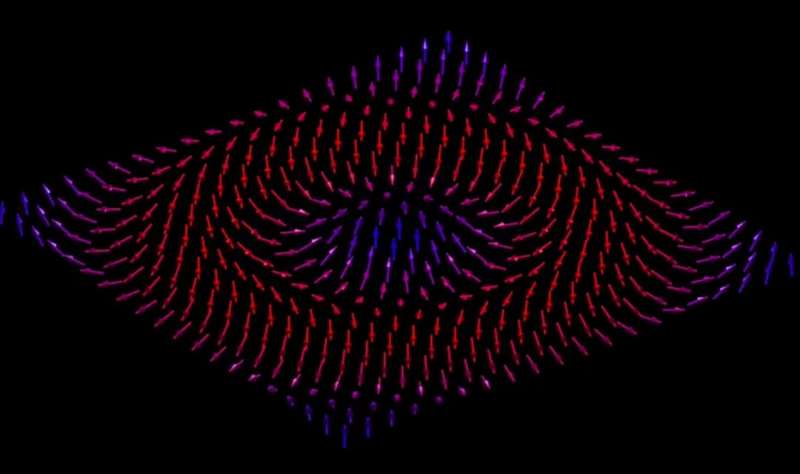Revolutionizing computer memory—with magnets

When the energy efficiency of electronics poses a challenge, magnetic materials may have a solution.
Energy efficiency will make or break the future. As the demand for energy from electronics continues growing, the Semiconductor Research Corporation warns that within two decades, the global computational demand for energy will be greater than the total amount produced. Vincent Sokalski, an assistant professor of materials science and engineering at Carnegie Mellon University, is working on a solution to this problem—using magnetic materials for energy-efficient memory and computing.
Sokalski recently received a $1.8 million grant from the Defense Advanced Research Projects Agency (DARPA) for his project, "Domain wall skyrmions: Topological excitations confined to 1-D channels." Along with CMU Professors Marc De Graef (MSE) and Di Xiao (Physics), Sokalski will explore new ways to efficiently process and store information with magnetic materials.
Although magnetic materials are already used in today's hard disk drives for long-term storage, semiconductors are currently used for short-term memory and processing, which is where most of the energy is consumed. However, as semiconductors shrink to meet consumer expectations for speed and density, there comes a limit to how small they can be made without risking the loss of information. DARPA recognizes this challenge, and research projects funded by DARPA's "Topological Excitations in Electronics" program center on finding ways to use "topological protection" to improve magnetic materials that can be used for computer memory storage or processors.
Imagine a bowl with a small ball rolling inside. As you shake it, the ball moves up and down the walls of the bowl, staying inside. However, if you did this with a smaller bowl, the ball might eventually fall out. Similarly, when a semiconductor is exposed to heat, it is at risk of losing information. The smaller you manufacture semiconductors, the more risk there is of data loss.
"The fundamental physics behind that isn't something we can readily change," explains Sokalski, "but we can look at entirely different material systems and mechanisms where we're moving around magnetic features, and using those magnetic features to change the resistance of a computing device. But in order to do that, we really need to explore and discover new materials that can serve that purpose."
Enter magnetic materials. By improving magnetic materials, Sokalski hopes to one day find new materials that could augment, or even replace, semiconductors in computing.
Sokalski's project begins with magnetic skyrmions, or 2-D magnetic bubbles. If used in computer memory, each bubble would store a single bit of data.
"Skyrmions are a rebirth of the idea of bubble memory" that was widely studied in the 1970s and 80s, says Sokalski. "Except now the bubbles are much smaller, more stable, and have topological protection, so we can move them around with greater energy efficiency than we ever could have moved them around 40 or 50 years ago."
In magnetic materials, think of each electron as a tiny bar magnet with a north and south pole that are all pointing in the same direction. These are called spins. Sokalski is interested in how to create topological defects in lines of these spins.
To understand the importance of topological protection, you first have to understand topological defects. Imagine stacking a cheese tray with a friend. One of you starts on the right side of the tray, stacking up each piece of cheese on top of the next, and the other starts on the left side. Eventually, you'll meet in the middle, and your slices of cheese will collide, rather than aligning at the same angle. That point where they collide is the essence of a topological defect.
To erase a topological defect, you'd have to flip every "slice of cheese" on one side of the defect. In magnetism, if half of your spins in a chain point inward to the left, and all the others point the opposite direction, you'd get a defect in the middle. In order to make the defect disappear, you'd have to reverse every spin on one side, moving it away to the edge of the chain.
In magnetism, these topological defects are very valuable. If you have a topological defect, that means your data are topologically protected, because if just one spin spontaneously flips to point in the opposite direction, the defect just shifts, rather than goes away.
Why is this topic suddenly emerging in magnetic materials research? All magnetism is based on something called the Heisenberg Exchange, a quantum mechanical effect that causes electron spins to align in a parallel orientation. However, the discovery of a new phenomenon called the Dzyaloshinskii-Moriya Interaction (DMI) leads to a perpendicular alignment of neighboring spins. The combination of Heisenberg Exchange and DMI, which is what Sokalski studies, gives rise to a new kind of magnetism that causes electron spins to have a continuously spiraling configuration.
"It turns out that features in magnetic materials that are stabilized by this new interaction can actually be manipulated with better efficiency than in cases where it's only the Heisenberg Exchange," says Sokalski.
Having greater control over skyrmions and topological defects would mean more reliable data storage and energy efficiency in computing.
"DARPA is looking to circumvent the pending challenge of energy-efficient electronics," says Sokalski, "and that scales from the most fundamental physical concepts of spin to the design of computers that have an entirely different circuit architecture. Our research will lead to energy-efficient computing that meets the needs of artificial intelligence and small-scale computers, while mitigating their global energy footprint."
MSE Ph.D. students Maxwell Li and Derek Lau and Physics postdoctoral researcher Ran Cheng are collaborators on this project, in addition to Co-PIs Tim Mewes and Claudia Mewes at the University of Alabama.




















